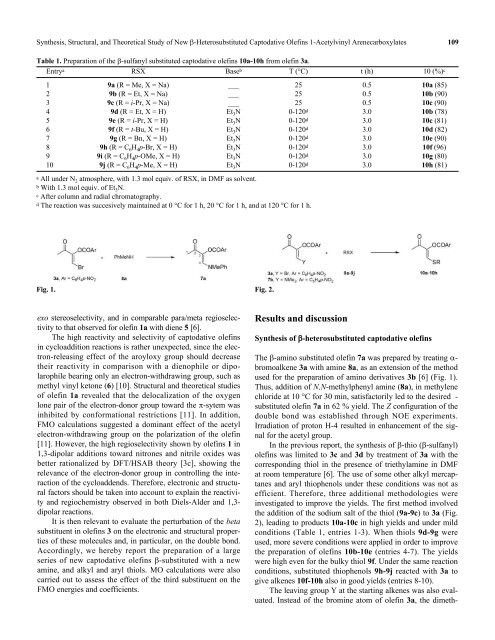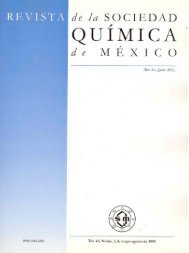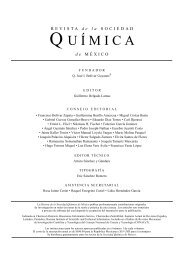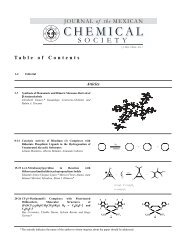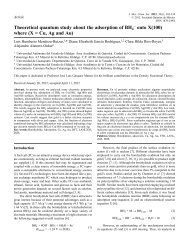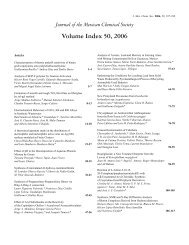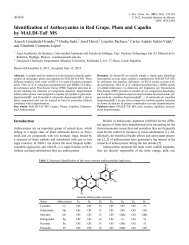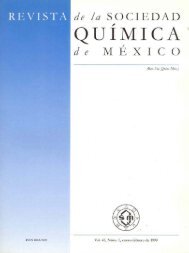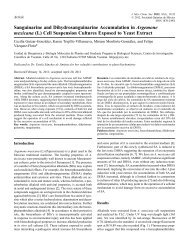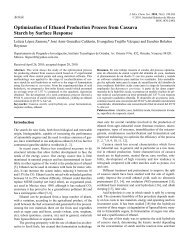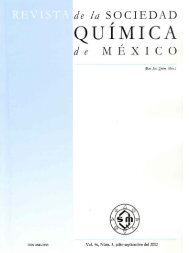SMQ-V047 N-002_ligas_size.pdf - Journal of the Mexican Chemical ...
SMQ-V047 N-002_ligas_size.pdf - Journal of the Mexican Chemical ...
SMQ-V047 N-002_ligas_size.pdf - Journal of the Mexican Chemical ...
Create successful ePaper yourself
Turn your PDF publications into a flip-book with our unique Google optimized e-Paper software.
Syn<strong>the</strong>sis, Structural, and Theoretical Study <strong>of</strong> New β-Heterosubstituted Captodative Olefins 1-Acetylvinyl Arenecarboxylates 109<br />
Table 1. Preparation <strong>of</strong> <strong>the</strong> β-sulfanyl substituted captodative olefins 10a-10h from olefin 3a.<br />
Entry a RSX Base b T (°C) t (h) 10 (%) c<br />
1 9a (R = Me, X = Na) ___ 25 0.5 10a (85)<br />
2 9b (R = Et, X = Na) ___ 25 0.5 10b (90)<br />
3 9c (R = i-Pr, X = Na) ___ 25 0.5 10c (90)<br />
4 9d (R = Et, X = H) Et 3 N 0-120 d 3.0 10b (78)<br />
5 9e (R = i-Pr, X = H) Et 3 N 0-120 d 3.0 10c (81)<br />
6 9f (R = t-Bu, X = H) Et 3 N 0-120 d 3.0 10d (82)<br />
7 9g (R = Bn, X = H) Et 3 N 0-120 d 3.0 10e (90)<br />
8 9h (R = C 6 H 4 p-Br, X = H) Et 3 N 0-120 d 3.0 10f (96)<br />
9 9i (R = C 6 H 4 p-OMe, X = H) Et 3 N 0-120 d 3.0 10g (80)<br />
10 9j (R = C 6 H 4 p-Me, X = H) Et 3 N 0-120 d 3.0 10h (81)<br />
a All under N 2 atmosphere, with 1.3 mol equiv. <strong>of</strong> RSX, in DMF as solvent.<br />
b With 1.3 mol equiv. <strong>of</strong> Et 3 N.<br />
c After column and radial chromatography.<br />
d The reaction was succesively maintained at 0 °C for 1 h, 20 °C for 1 h, and at 120 °C for 1 h.<br />
Fig. 1. Fig. 2.<br />
exo stereoselectivity, and in comparable para/meta regioselectivity<br />
to that observed for olefin 1a with diene 5 [6].<br />
The high reactivity and selectivity <strong>of</strong> captodative olefins<br />
in cycloaddition reactions is ra<strong>the</strong>r unexpected, since <strong>the</strong> electron-releasing<br />
effect <strong>of</strong> <strong>the</strong> aroyloxy group should decrease<br />
<strong>the</strong>ir reactivity in comparison with a dienophile or dipolarophile<br />
bearing only an electron-withdrawing group, such as<br />
methyl vinyl ketone (6) [10]. Structural and <strong>the</strong>oretical studies<br />
<strong>of</strong> olefin 1a revealed that <strong>the</strong> delocalization <strong>of</strong> <strong>the</strong> oxygen<br />
lone pair <strong>of</strong> <strong>the</strong> electron-donor group toward <strong>the</strong> π-sytem was<br />
inhibited by conformational restrictions [11]. In addition,<br />
FMO calculations suggested a dominant effect <strong>of</strong> <strong>the</strong> acetyl<br />
electron-withdrawing group on <strong>the</strong> polarization <strong>of</strong> <strong>the</strong> olefin<br />
[11]. However, <strong>the</strong> high regioselectivity shown by olefins 1 in<br />
1,3-dipolar additions toward nitrones and nitrile oxides was<br />
better rationalized by DFT/HSAB <strong>the</strong>ory [3c], showing <strong>the</strong><br />
relevance <strong>of</strong> <strong>the</strong> electron-donor group in controlling <strong>the</strong> interaction<br />
<strong>of</strong> <strong>the</strong> cycloaddends. Therefore, electronic and structural<br />
factors should be taken into account to explain <strong>the</strong> reactivity<br />
and regiochemistry observed in both Diels-Alder and 1,3-<br />
dipolar reactions.<br />
It is <strong>the</strong>n relevant to evaluate <strong>the</strong> perturbation <strong>of</strong> <strong>the</strong> beta<br />
substituent in olefins 3 on <strong>the</strong> electronic and structural properties<br />
<strong>of</strong> <strong>the</strong>se molecules and, in particular, on <strong>the</strong> double bond.<br />
Accordingly, we hereby report <strong>the</strong> preparation <strong>of</strong> a large<br />
series <strong>of</strong> new captodative olefins β-substituted with a new<br />
amine, and alkyl and aryl thiols. MO calculations were also<br />
carried out to assess <strong>the</strong> effect <strong>of</strong> <strong>the</strong> third substituent on <strong>the</strong><br />
FMO energies and coefficients.<br />
Results and discussion<br />
Syn<strong>the</strong>sis <strong>of</strong> β-heterosubstituted captodative olefins<br />
The β-amino substituted olefin 7a was prepared by treating α-<br />
bromoalkene 3a with amine 8a, as an extension <strong>of</strong> <strong>the</strong> method<br />
used for <strong>the</strong> preparation <strong>of</strong> amino derivatives 3b [6] (Fig. 1).<br />
Thus, addition <strong>of</strong> N,N-methylphenyl amine (8a), in methylene<br />
chloride at 10 °C for 30 min, satisfactorily led to <strong>the</strong> desired -<br />
substituted olefin 7a in 62 % yield. The Z configuration <strong>of</strong> <strong>the</strong><br />
double bond was established through NOE experiments.<br />
Irradiation <strong>of</strong> proton H-4 resulted in enhancement <strong>of</strong> <strong>the</strong> signal<br />
for <strong>the</strong> acetyl group.<br />
In <strong>the</strong> previous report, <strong>the</strong> syn<strong>the</strong>sis <strong>of</strong> β-thio (β-sulfanyl)<br />
olefins was limited to 3c and 3d by treatment <strong>of</strong> 3a with <strong>the</strong><br />
corresponding thiol in <strong>the</strong> presence <strong>of</strong> triethylamine in DMF<br />
at room temperature [6]. The use <strong>of</strong> some o<strong>the</strong>r alkyl mercaptanes<br />
and aryl thiophenols under <strong>the</strong>se conditions was not as<br />
efficient. Therefore, three additional methodologies were<br />
investigated to improve <strong>the</strong> yields. The first method involved<br />
<strong>the</strong> addition <strong>of</strong> <strong>the</strong> sodium salt <strong>of</strong> <strong>the</strong> thiol (9a-9c) to 3a (Fig.<br />
2), leading to products 10a-10c in high yields and under mild<br />
conditions (Table 1, entries 1-3). When thiols 9d-9g were<br />
used, more severe conditions were applied in order to improve<br />
<strong>the</strong> preparation <strong>of</strong> olefins 10b-10e (entries 4-7). The yields<br />
were high even for <strong>the</strong> bulky thiol 9f. Under <strong>the</strong> same reaction<br />
conditions, substituted thiophenols 9h-9j reacted with 3a to<br />
give alkenes 10f-10h also in good yields (entries 8-10).<br />
The leaving group Y at <strong>the</strong> starting alkenes was also evaluated.<br />
Instead <strong>of</strong> <strong>the</strong> bromine atom <strong>of</strong> olefin 3a, <strong>the</strong> dimeth-


